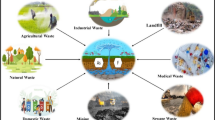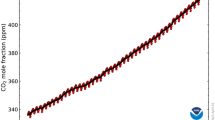Abstract
Acid mine drainage (AMD) from abandoned and active mines continues to pose a serious threat to the environment. Metal-rich fluids may emerge from abandoned mine works for hundreds of years, so the long-term performance of treatment systems must be evaluated to minimize the environmental impacts of AMD. A two-step process consisting of an aerobic wetland and a limestone bed is being used to treat coal mine-derived AMD in the Huff Run watershed of eastern Ohio, USA, and has been in operation for over 13 years. In 2002, the water was acidic (3.66 pH). From 2004 to 2014, water entering the treatment system had a pH of ~ 5.7 that increased to 7.25 by the time it exited the limestone bed. Since 2004, the effluent Al, Mn, and Fe concentrations have been between 0.05 and 0.12 mg/L, 0.04 and 0.25 mg/L, and 0.05 and 0.34 mg/L, respectively, with the majority of Fe and Al removal occurring in the wetland along with partial Mn removal. Subsequently, further Mn removal occurs as AMD flows through a limestone bed that was inoculated with a consortium of Mn(II)-oxidizing bacteria at the time of construction. An evaluation of historical system performance and current conditions indicate that effective metal removal has been sustained for over 13 years. While Mn(II)-oxidizing bacteria were most abundant in the limestone bed, they were detected throughout the system, indicating that indigenous Mn(II)-oxidizing microorganisms may be contributing to Mn removal well after the inoculation of the system.




Similar content being viewed by others
References
Aguiar AO, Duarte RA, Ladeira ACQ (2013) The application of MnO2 in the removal of manganese from acid mine water. Water Air Soil Pollut 224:1690–1698
Akcil A, Koldas S (2006) Acid mine drainage (AMD): causes, treatment and case studies. J Clean Prod 14:1139–1145
Bai H, Kang Y, Quan H, Han Y, Sun J, Feng Y (2013) Treatment of acid mine drainage by sulfate reducing bacteria with iron in bench scale runs. Bioresour Technol 128:818–822
Baker BJ, Banfield JF (2003) Microbial communities in acid mine drainage. FEMS Microbiol Ecol 44:139–152
Batty L, Hooley D, Younger P (2008) Iron and manganese removal in wetland treatment systems: rates, processes, and implications for management. Sci Total Environ 394:1–8
Bohu T, Santelli CM, Akob DM, Neu TR, Ciobota V, Rösch P, Popp J, Nietzsche S, Küsel K (2015) Characterization of pH dependent Mn(II) oxidation strategies and formation of a bixbyite-like phase by Mesorhizobium australicum T-G1. Front Microbiol 6:734
Box GEP, Cox DR (1964) An analysis of transformations. J R Stat Soc Ser B 26:211–252
Brantner JS, Senko JM (2014) Response of soil-associated microbial communities to intrusion of coal mine-derived acid mine drainage. Environ Sci Technol 48:8556–8563
Brantner JS, Haake ZJ, Burwick JE, Menge CM, Hotchkiss ST, Senko JM (2014) Depth-dependent geochemical and microbiological gradients in Fe(III) deposits resulting from coal mine-derived acid mine drainage. Front Microbiol 5:2215–2218
Chaput DL, Hansel CM, Burgos WD, Santelli SM (2015) Profiling microbial communities in manganese remediation systems treating coal mine drainage. Appl Environ Microbiol 81:2189–2198
Cravotta CA III (2008) Dissolved metals and associated constituents in abandoned coal-mine discharges, Pennsylvania, USA. Part 1: constituent quantities and correlations. Appl Geochem 23:166–202
Duarte RA, Ladeira AC (2011) Study of manganese removal from mining effluent. In: IMWA Conference, Aachen Germany, pp 297–300
Francis CA, Tebo BM (2001) Enzymatic manganese(II) oxidation by a marine α-proteobacterium. Appl Environ Microbiol 67:4024–4029
Gazea B, Adam K, Kontopoulos A (1996) A review of passive systems for the treatment of acid mine drainage. Miner Eng 9:23–42
Gray JB, Vis ML (2013) Reference diatom assemblage response to restoration of an acid mine drainage stream. Ecol Indic 29:234–245
Hallberg KB, Johnson DB (2003) Novel acidophiles isolated from moderately acidic mine drainage waters. Hyrdometallurgy 71:139–148
Hallberg KB, Johnson DB (2005) Biological manganese removal from acid mine drainage in constructed wetlands and prototype bioreactors. Sci Total Environ 338:115–124
HRWRP (2014) NPS Report—Huff Run Watershed Report. http://www.watersheddata.com/userview_file.aspx?UserFileLo=1&UserFileID=177. Accessed Nov 2017
HRWRP (2015) Surface water database. http://www.watersheddata.com/map/map.aspx?WaterShed=HR1. Accessed Nov 2017
HRWRP, Huff Run Watershed-Linden Bioremediation Project (2003) Non-point source monitoring system. http://watersheddata.com/userview_file.aspx?UserFileLo=2&UserFileID=377. Accessed Nov 2017
Johnson DB (1995) Selective solid media for isolating and enumerating acidophilic bacteria. J Microbiol Methods 23:205–218
Johnson DB, Hallberg KB (2002) Pitfalls of passive mine water treatment. Rev Environ Sci Biotechnol 1:335–343
Johnson DB, Hallberg KB (2005) Acid mine drainage remediation options: a review. Sci Total Environ 338:3–14
Lagos GI (2011) The use of bench-scale treatability studies in the design of engineered wetlands for the remediation of acid mine drainage (AMD) and leachate in the vicinity of coal mines. A case study in Ohio, United States. Proc Earth Planet Sci 3:11–16
Larson LN, Sanchez-Espana J, Burgos W (2014) Rates of low-pH biological Fe(II) oxidation in the Appalachian bituminous coal basin and the Iberian pyrite belt. Appl Geochem 47:85–98
Learman DR, Wankel SD, Webb SM, Martinez N, Madden AS, Hansel CM (2011) Coupled biotic-abiotic Mn(II) oxidation pathway mediates the formation and structural evolution of biogenic Mn oxides. Geochim Cosmochim Acta 75:6048–6063
Luan F, Santelli CM, Hansel CM, Burgos WD (2012) Defining manganese(II) removal processes in passive coal mine drainage treatment systems through laboratory incubation experiments. Appl Geochem 27:1567–1578
Luptakova A, Ubaldini S, Macingova E, Fornari P, Guiliano V (2012) Application of physical-chemical and biological-chemical methods for heavy metals removal from acid mine drainage. Proc Biochem 47:1633–1639
Matlock MM, Howerton BS, Atwood DA (2002) Chemical precipitation of heavy metals from acid mine drainage. Water Res 36:4757–4764
Matthies R, Aplin AC, Jarvis AP (2010) Performance of a passive treatment systems for net-acidic coal mine drainage over five years of operation. Sci Total Environ 408:4877–4885
Mays PA, Edwards GS (2001) Comparison of heavy metal accumulation in a natural wetland and constructed wetlands receiving acid mine drainage. Ecol Eng 16:487–500
ODNR (Ohio Department Natural Resources (2008) High calcium limestones in Ohio. GeoFacts 25. http://www.OhioGeology.com. Accessed Nov 2017
Outram JG, Couperthwaite SJ, Millar GJ (2018) Enhance removal of high Mn(II) and minor heavy metals from acid mine drainage using tunneled manganese oxides. J Environ Chem Eng 6:3249–3261
Riefler RG, Krohn J, Stuart B, Socotch C (2008) Role of sulfur-reducing bacteria in a wetland system treating acid mine drainage. Sci Total Environ 394:222–229
Robinson-Lora MA, Brennan RA (2010) Biosorption of manganese onto chitin and associated proteins during the treatment of mine impacted water. Chem Eng J 162:565–572
Santelli CM, Pfister DH, Lazarus D, Sun L, Burgos WD, Hansel CM (2010) Promotion of Mn(II) oxidation and remediation of cola mine drainage in passive treatment systems of diverse fungal and bacterial communities. Appl Environ Microbiol 76:4871–4875
Santelli CM, Webb SM, Dohnalkova AC, Hansel CM (2011) Diversity of oxides produced by Mn(II)-oxidizing fungi. Geochim Cosmochim Acta 75:2762–2776
Schaider LA, Senn DB, Estes ER, Brabander DJ, Shine JP (2014) Sources and fates of heavy metals in a mining-impacted stream: temporal variability and the role of iron oxides. Sci Total Environ 490:456–466
Senko JM, Wanjugi P, Lucas M, Bruns MA, Burgos WD (2008) Characterization of Fe(II) oxidizing bacterial communities at two acidic Appalachian coal mine drainage impacted sites. ISME J 2:1134–1145
Sikora FJ, Behrends LL, Brodie GA, Taylor HN (2000) Design criteria and required chemistry for removing manganese in acid mine drainage using subsurface flow wetlands. Water Environ Res 72:536–544
Silva AM, Cruz FLS, Lima RMF, Teixeira MC, Leao VA (2010) Manganese interactions during mine water treatment. J Hazard Mater 181:514–520
Silva AM, Cunha EC, Silva FDR, Leao VA (2012) Treatment of high-manganese mine water with limestone and sodium carbonate. J Clean Prod 29–30:11–19
Simate GS, Ndlovu S (2014) Acid mine drainage: challenges and opportunities. J Environ Chem Eng 2:1785–1803
Skousen JG, Sexstone A, Ziemkiewica PF (2000) Acid mine drainage control and treatment: reclamation of drastically disturbed lands, American Society of Agronomy and American Society for Surface Mining and Reclamation. Agronomy No. 41
Skousen J, Zipper CE, Rose A, Ziemkiewica PF, Nairn R, McDonald LM, Kleinmann RL (2017) Review of passive systems for acid mine drainage. Mine Water Environ 36:133–153
Socotch C, Gue J, Seger NA, Uranowski L (2003) Development of the Linden AMD bioremediation system: Huff Run watershed, Tuscarawas and Carroll County, Ohio. http://www.huffrun.org. Accessed Nov 2017
Stookey LL (1970) Ferrozine—a new spectrophotometric reagent for iron. Anal Chem 42:779–781
Tan H, Zhang G, Heaney PJ, Webb SM, Burgos WD (2010) Characterization of manganese oxide precipitates from Appalachian coal mine drainage treatment systems. Appl Geochem 25:389–399
Tang Y, Zeiner CA, Santelli CM, Hansel CM (2013) Fungal oxidative dissolution of the Mn(II)-bearing mineral rhodochrosite and the role of metabolites in manganese oxide formation. Environ Microbiol 15:1063–1077
Tarutis WJ Jr, Unz RF (1995) Iron and manganese release in coal mine drainage wetland microcosms. Water Sci Technol 32:187–192
Tebo BM, Bargar JR, Clement BG, Dick GJ, Murray KJ, Parker D, Verity R, Webb SM (2004) Biogenic manganese oxides: properties and mechanisms of formation. Ann Rev Earth Planet Sci 32:287–328
Tebo BM, Johnson HA, McCarthy JK, Templeton AS (2005) Geomicrobiology of manganese(II) oxidation. Trends Microbiol 13:421–428
USGS (US Geological Survey) (2018) Geologic units in Tuscarawas county, Ohio. https://mrdata.usgs.gov/geology/state/fips-unit.php?code=f39157. Accessed Nov 2017
Vail WJ, Riley RK (1995) Process for removing manganese from solutions including aqueous industrial waste. United States Patent Number 5,441,641
Valente TM, Antunes M, Braga AS, Prudencio MI, Marques R, Pamplona J (2012) Mineralogical attenuation fro metallic remediation in a passive system for mine water treatment. Environ Earth Sci 66:39–54
White RA, Freeman C, Kang H (2011) Plant-derived phenolic compounds impair the remediation of acid mine drainage using treatment wetlands. Ecol Eng 37:172–175
Wilkin RT (2008) Containment attenuation processes at mine sites. Mine Water Environ 27:251–258
Wise M (2010) Huff Run watershed plan. http://www.water.ohiodnr.gov/portals/soilwater/downloads/wap/HuffRun.pdf. Accessed Nov 2017
Ye ZH, Whiting SN, Lin ZQ, Lytlem CM, Qian JH, Terry N (2001) Removal and distribution of iron, manganese, cobalt and nickel within a Pennsylvanian constructed wetland treating coal combustion by-product leachate. J Environ Qual 30:1464–1473
Younger PL (1997) The longevity of minewater pollution: a basis for decision-making. Sci Total Environ 194/195:457–466
Zipper CE, Skousen JG (2010) Influent water quality affects performance of passive treatment systems for acid mine drainage. Mine Water Environ 29:135–143
Acknowledgements
This research was funded by the Ohio Department of Natural Resources (ID 1000002426). The contents do not necessarily reflect the official views or policies of the Ohio Department of Natural Resources. Maps were created using ArcGIS® software by Esri. ArcGIS® and ArcMap™ are the intellectual property of Esri and are used herein under license. Copyright © Esri. All rights reserved. http://www.esri.com.
Author information
Authors and Affiliations
Corresponding author
Additional information
Publisher’s Note
Springer Nature remains neutral with regard to jurisdictional claims in published maps and institutional affiliations.
This article is a part of a Topical Collection in Environmental Earth Sciences on Water Resources and Hydraulic Engineering, guest edited by Drs. Yanqing Lian, Walton Kelly, and Fulin Li.
Electronic supplementary material
Below is the link to the electronic supplementary material.
Rights and permissions
About this article
Cite this article
Crafton, E., Pritchard, C., Guo, L. et al. Dynamics of Mn removal in an acid mine drainage treatment system over 13 years after installation. Environ Earth Sci 78, 10 (2019). https://doi.org/10.1007/s12665-018-8008-z
Received:
Accepted:
Published:
DOI: https://doi.org/10.1007/s12665-018-8008-z




